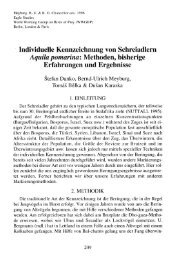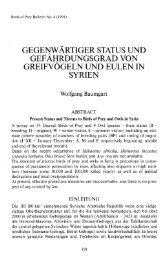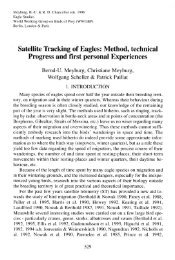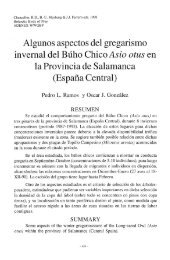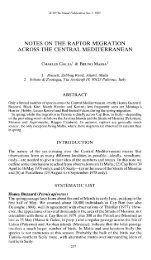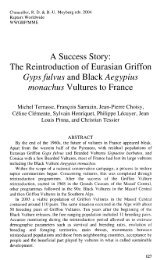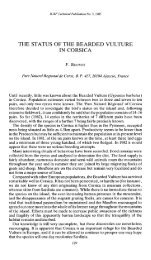Action Plan for the Recovery and Conservation of Vultures on the ...
Action Plan for the Recovery and Conservation of Vultures on the ...
Action Plan for the Recovery and Conservation of Vultures on the ...
You also want an ePaper? Increase the reach of your titles
YUMPU automatically turns print PDFs into web optimized ePapers that Google loves.
Kladenez in <str<strong>on</strong>g>the</str<strong>on</strong>g> eastern Rhodopes (Marin et al. 1998; S. Marin pers. comm.).<br />
In 2003, a new successful breeding pair was recorded in <str<strong>on</strong>g>the</str<strong>on</strong>g> same regi<strong>on</strong> (H.<br />
Hristov pers. comm.), where a group <str<strong>on</strong>g>of</str<strong>on</strong>g> seven Black <str<strong>on</strong>g>Vultures</str<strong>on</strong>g> is resident. The<br />
Griff<strong>on</strong> Vulture col<strong>on</strong>ies in <str<strong>on</strong>g>the</str<strong>on</strong>g> eastern Rhodopes were reduced to 16-20 birds<br />
in 1978 but had increased to more than 100 in 2000. In 1998, a new col<strong>on</strong>y was<br />
found close to Studen Kladenetz, a distance <str<strong>on</strong>g>of</str<strong>on</strong>g> 18km from <str<strong>on</strong>g>the</str<strong>on</strong>g> first <strong>on</strong>e near<br />
Madjarovo (Stoynov 2001a). The numbers <str<strong>on</strong>g>of</str<strong>on</strong>g> Griff<strong>on</strong> <str<strong>on</strong>g>Vultures</str<strong>on</strong>g> is slowly<br />
increasing. In 2002 31 Griff<strong>on</strong> Vulture pairs bred <str<strong>on</strong>g>and</str<strong>on</strong>g> 20 nestlings Hedged<br />
(BSPB/BirdLife Bulgaria, 2002), increasing to 33 Griff<strong>on</strong> Vulture pairs, 29<br />
breeding attempts <str<strong>on</strong>g>and</str<strong>on</strong>g> 21 fledged young during 2003. In total, a minimum <str<strong>on</strong>g>of</str<strong>on</strong>g><br />
118 individuals is now present (H. Hristov, BSPB/BirdLife Bulgaria, in litt, to<br />
BSBCP, 2004). In 2003, <str<strong>on</strong>g>the</str<strong>on</strong>g> Egyptian Vulture populati<strong>on</strong> was estimated at 65-<br />
80 breeding pairs. This species is suffering from a slow but c<strong>on</strong>tinuous<br />
decrease, having lost, in <str<strong>on</strong>g>the</str<strong>on</strong>g> past seven years, 14 breeding territories, <str<strong>on</strong>g>and</str<strong>on</strong>g>, since<br />
1980, 45 breeding pairs have disappeared (M. Kurtev, BSPB/BirdLife<br />
Bulgaria, in litt, to BVCF, 2004).<br />
Serbia<br />
In Serbia, all four vulture species were widely distributed at <str<strong>on</strong>g>the</str<strong>on</strong>g> beginning<br />
<str<strong>on</strong>g>of</str<strong>on</strong>g> <str<strong>on</strong>g>the</str<strong>on</strong>g> 20"' century (Marinkovic & Orl<str<strong>on</strong>g>and</str<strong>on</strong>g>ic 1994). The Bearded <str<strong>on</strong>g>and</str<strong>on</strong>g> Black<br />
Vulture became extinct after World War II <str<strong>on</strong>g>and</str<strong>on</strong>g> during <str<strong>on</strong>g>the</str<strong>on</strong>g> following decades<br />
birds have <strong>on</strong>ly been sporadically observed (Grubac 1998b). Maps detailing<br />
Bearded Vulture observati<strong>on</strong>s <str<strong>on</strong>g>for</str<strong>on</strong>g> <str<strong>on</strong>g>the</str<strong>on</strong>g> past few decades can be found in Grubac<br />
(2002). Today <str<strong>on</strong>g>the</str<strong>on</strong>g>re are three Griff<strong>on</strong> Vulture breeding col<strong>on</strong>ies, with a total <str<strong>on</strong>g>of</str<strong>on</strong>g><br />
65-75 breeding pairs, producing 56 young in 2003. In <str<strong>on</strong>g>the</str<strong>on</strong>g> south <str<strong>on</strong>g>of</str<strong>on</strong>g> <str<strong>on</strong>g>the</str<strong>on</strong>g> country,<br />
2-3 Egyptian Vulture breeding pairs are still present (Grubac & Pusovic 2003).<br />
Greece<br />
In <str<strong>on</strong>g>the</str<strong>on</strong>g> past, all four vulture species were abundant in Greece (H<str<strong>on</strong>g>and</str<strong>on</strong>g>rinos<br />
1985). The Bearded Vulture recently became extinct <strong>on</strong> <str<strong>on</strong>g>the</str<strong>on</strong>g> mainl<str<strong>on</strong>g>and</str<strong>on</strong>g>, although<br />
observati<strong>on</strong>s <str<strong>on</strong>g>of</str<strong>on</strong>g> single birds have been made in <str<strong>on</strong>g>the</str<strong>on</strong>g> Pindos <str<strong>on</strong>g>and</str<strong>on</strong>g> Pinovo<br />
Mountains. On Crete, <str<strong>on</strong>g>the</str<strong>on</strong>g> populati<strong>on</strong> dropped from 10-12 pairs in <str<strong>on</strong>g>the</str<strong>on</strong>g> 1980s<br />
(Geroudet 1981 ; Vagliano 1981) to 9-10 pairs in 1995 <str<strong>on</strong>g>and</str<strong>on</strong>g> to four pairs in 2002<br />
(Xirouchakis 2002). The Black Vulture's last refuge <strong>on</strong> <str<strong>on</strong>g>the</str<strong>on</strong>g> Balkan Peninsula is<br />
in <str<strong>on</strong>g>the</str<strong>on</strong>g> Dadia Forest Reserve (Evros, Thrace) where, in 1993, a col<strong>on</strong>y <str<strong>on</strong>g>of</str<strong>on</strong>g> about<br />
15 breeding pairs remained (Spyropoulou 1998; Hallmann 1998a). In 2003, <str<strong>on</strong>g>the</str<strong>on</strong>g><br />
col<strong>on</strong>y was stable, c<strong>on</strong>sisting <str<strong>on</strong>g>of</str<strong>on</strong>g> 19 breeding pairs (T. Skartsi et al 2003.). A<br />
small col<strong>on</strong>y <str<strong>on</strong>g>of</str<strong>on</strong>g> two pairs <str<strong>on</strong>g>and</str<strong>on</strong>g> seven birds <strong>on</strong> Mount Olympos became extinct<br />
<strong>on</strong>ly a few years after having been discovered in 1983 (Hallmann 1998b). The<br />
Hellenic Ornithological Society (HOS) <str<strong>on</strong>g>and</str<strong>on</strong>g> <str<strong>on</strong>g>the</str<strong>on</strong>g> Eastern Griff<strong>on</strong> Vulture<br />
Working Group (EGVWG) recently showed that <str<strong>on</strong>g>the</str<strong>on</strong>g> Griff<strong>on</strong> Vulture col<strong>on</strong>ies<br />
<strong>on</strong> mainl<str<strong>on</strong>g>and</str<strong>on</strong>g> Greece have declined by 50% in <str<strong>on</strong>g>the</str<strong>on</strong>g> last 10 years. In 2001 <str<strong>on</strong>g>the</str<strong>on</strong>g><br />
populati<strong>on</strong> was estimated at 21-34 breeding pairs in nine col<strong>on</strong>ies. A stable<br />
populati<strong>on</strong> is present <strong>on</strong> Crete (34 col<strong>on</strong>ies) <str<strong>on</strong>g>and</str<strong>on</strong>g> <str<strong>on</strong>g>the</str<strong>on</strong>g> Cyclades (two col<strong>on</strong>ies),<br />
where 154-158 pairs were found in 2002 (Bourdakis 2003). The populati<strong>on</strong><br />
figures provided by <str<strong>on</strong>g>the</str<strong>on</strong>g> Hellenic Vulture Working Group <str<strong>on</strong>g>for</str<strong>on</strong>g> 2003 are 98-144<br />
pairs (22 col<strong>on</strong>ies) <str<strong>on</strong>g>for</str<strong>on</strong>g> Crete <str<strong>on</strong>g>and</str<strong>on</strong>g> <str<strong>on</strong>g>the</str<strong>on</strong>g> Cyclades <str<strong>on</strong>g>and</str<strong>on</strong>g> a total <str<strong>on</strong>g>of</str<strong>on</strong>g> 115-178 pairs <str<strong>on</strong>g>for</str<strong>on</strong>g><br />
Greece (Hallmann 2004; B. Hallmann pers. comm.). During <str<strong>on</strong>g>the</str<strong>on</strong>g> last ten years,<br />
154



